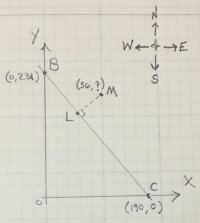It seems like the OP has lost interest, so I'll finish this exercise as an example for future readers.
The slopes of a pair of perpendicular lines are negative reciprocals of each other. We know the slope of line BC is -231/190. Therefore, the slope of line LM is +190/231.
When we know a line's slope and the coordinates of a point on the line, then the
Point-Slope Formula can be used to write the equation of a line.
For line LM, we know the slope is 190/231 and the coordinates of a point are (56,191). Therefore, the equation of line LM is:
y - 191 = (190/231)(x - 56)
In Slope-Intercept form, we now have a system of two linear equations:
Line BC: y = -(231/190)x + 231
Line LM: y = (190/231)x + 4783/33
The solution to this system gives the location of point L (the intersection point of lines BC and LM).
Using the
Substitution Method for solving a system, we can replace symbol y in the second equation with its definition from the first equation (because point L lies on both lines):
-(231/190)x + 231 = (190/231)x + 4783/33
Solving this new equation yields the x-coordinate of point L. Then, substituting that solution for x in one of the original equations yields the corresponding y-coordinate.
We find the exact coordinates of point L are (3777200/89461, 16073211/89461).
Those improper fractions will not be nice to work with, so I'm going to proceed based on an assumption that the minutes (for the plane to travel from B to L) are to be reported in decimal form, rounded to the nearest tenth of a minute. Switching to decimal approximations for the remaining work, I'll round all intermediate results to three decimal places, to avoid
round-off error in the final answer.
The rounded coordinates at point L are: (42.222, 179.667).
Next, the common relationship between distance traveled, speed (rate) and elapsed time is:
Distance = Rate × Time
Dividing each side of that equation by Rate yields a formula for Time:
Time = Distance/Rate
We know the plane's rate is 800 kph. We need the distance from B to L. We use the
Distance Formula for that part.
Distance
BL =
√[
(0 - 42.222)^2 +
(231 - 179.667)^2]
The estimated distance is 66.466 kilometers.
The estimated Time is 66.466/800 (Distance/Rate) or 0.083 hours.
We convert the estimated time from hours to minutes.
Rounded to the nearest tenth of a minute, my answer is, "You will be closest to Mount Rainier 5.0 minutes after passing the base."
?

